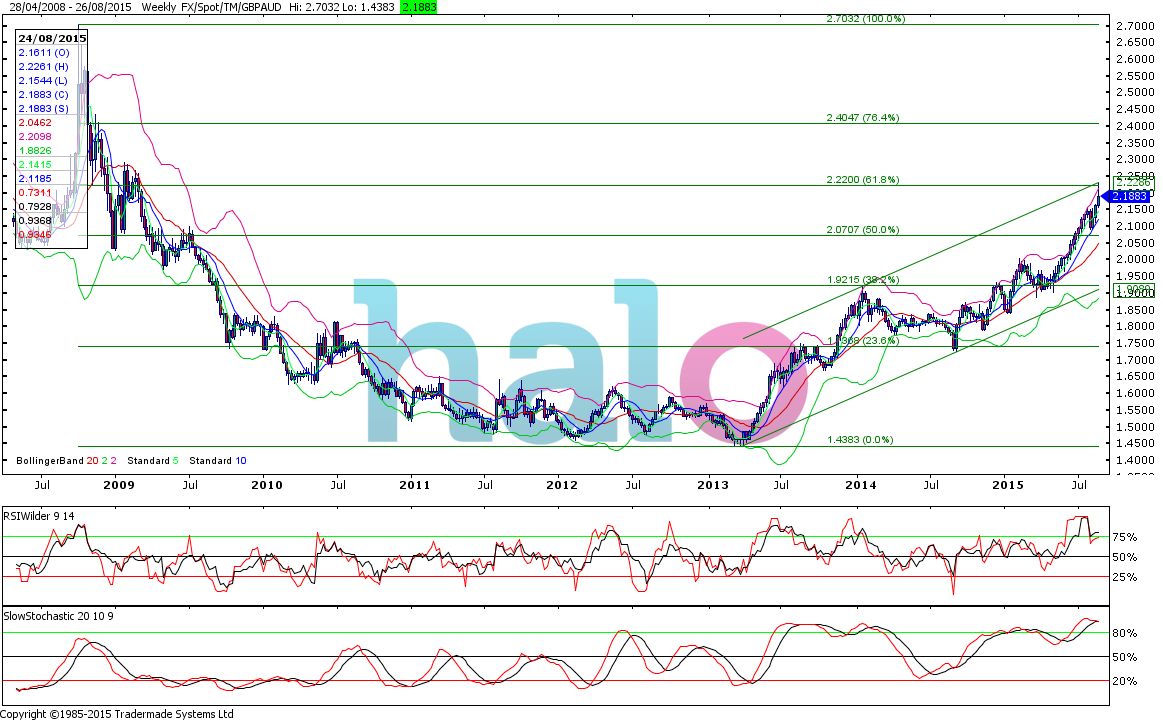Australian Dollar Research Report
Sterling Australian Dollar (GBPAUD) FX Technical Analysis
In a month where the RBA left interest rates on hold and the majority of Aussie data surprised to the upside, we have seen GBPAUD accelerate within the uptrend of the last couple of years.
UK data has been a bit of mixed bag over recent weeks, with UK inflation suggesting the Bank of England will raise rates sooner rather than later but UK retail sales failing to support this.
The main focus for the market has actually been events in China. With Chinese stock markets continuing to fall, the Chinese government re-valuing their currency and the PBoC (People’s Bank of China) cutting both the reserve requirements and headline interest rates fears over the outlook for the world’s 2nd economy have continue to grow.
As risk sentiment has taken a knock, we have seen US stock markets have their largest 4 day losing streak in history over the course of this week.
This financial market turmoil has spilled over into the currency markets and we have seen the Aussie sold accordingly. As Australia and China are such heavy trading partners a downturn in the outlook for China has a big impact for Australia. As a rule of thumb, commodity currencies (Aussie, Kiwi, Rand and CAD) tend to weaken when risk aversion increases.
Technically, GBPAUD remains within the long term uptrend that has been in place since hitting the 1.4383 lows in April 2013. This uptrend looks set to continue, although a short term correction cannot be ruled out as the move this week has been so aggressive. With a move to the 10 week moving average (2.1187) possible. This has underpinned the market since April so should continue to do so. Personally, I would suggest any correction is likely to run out of steam in the 2.15 region but only a move below 2.02 would suggest the uptrend has run its course.
As long as the market remains above 2.15 short term, then we should see a move higher. Of course the million dollar question is; where to trade? Realistically the next long term level of resistance is in the 2.22 region, as this coincides with the 61.8% Fibonacci level from the 2.7032-1.4383 move then I would suggest this makes a good target. It is worth putting this in context as rates of this nature are the best we have been able to offer since early 2009 i.e. more than a 6 year high.
Buyers:
As mentioned above, the trend is in your favour. Initially, targeting a rate in the 2.20 region seems sensible given the levels of resistance in the 2.22 region. If you have time on your side, you may wish to employ a price averaging strategy i.e. breaking your requirement down into smaller transactions and trading as the market moves.
Sellers:
Unfortunately, the trend remains firmly against you. As the old saying goes “let the trend be your friend”. In this case the market is moving away from you, so trading sooner rather than later seems the sensible strategy. We’re seeing a bit of a pull back from the highs at this stage, so it would be worth seeing how this correction plays out. It is worth noting that an uptrend is defined as series of higher peaks and higher lows, this is a pattern that remains intact, so I would expect 2.15 to be the limit of this correction and a move back above 2.22 would suggest the correction has been completed and the uptrend is resuming.
Trading foreign exchange on margin carries a high level of risk, and may not be suitable for all investors. The high degree of leverage can work against you as well as for you. Before deciding to invest in foreign exchange you should carefully consider your investment objectives, level of experience, and risk appetite. The possibility exists that you could sustain a loss of some or all of your initial investment and therefore you should not invest money that you cannot afford to lose. You should be aware of all the risks associated with foreign exchange trading, and seek advice from an independent financial advisor if you have any doubts.
Recommended Content
Editors’ Picks
EUR/USD retreats below 1.0700 after US GDP data

EUR/USD came under modest bearish pressure and retreated below 1.0700. Although the US data showed that the economy grew at a softer pace than expected in Q1, strong inflation-related details provided a boost to the USD.
GBP/USD declines below 1.2500 as USD rebounds

GBP/USD declined below 1.2500 and erased the majority of its daily gains with the immediate reaction to the US GDP report. The US economy expanded at a softer pace than expected in Q1 but the price deflator jumped to 3.4% from 1.8%.
Gold drops below $2,320 as US yields shoot higher

Gold lost its traction and turned negative on the day below $2,320 in the American session on Thursday. The benchmark 10-year US Treasury bond yield is up more than 1% on the day above 4.7% after US GDP report, weighing on XAU/USD.
XRP extends its decline, crypto experts comment on Ripple stablecoin and benefits for XRP Ledger

Ripple extends decline to $0.52 on Thursday, wipes out weekly gains. Crypto expert asks Ripple CTO how the stablecoin will benefit the XRP Ledger and native token XRP.
After the US close, it’s the Tokyo CPI

After the US close, it’s the Tokyo CPI, a reliable indicator of the national number and then the BoJ policy announcement. Tokyo CPI ex food and energy in Japan was a rise to 2.90% in March from 2.50%.
